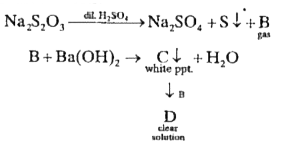The oxidation states of iron atoms in compounds (A) ,(B) and (C) , respectively , are x , y and z . The sum of x , y and z is _______
Na4[Fe(CN)5(A)(NOS)] Na4[FeO4](B) [Fe2(CO)9(C)]
To find the oxidation states of iron in the given compounds (A), (B), and (C), we will analyze each compound step by step.
Step 1: Determine the oxidation state of iron in compound (A)
The compound is given as Na4(Fe(CN)5(NOS)).
1. Identify the charges:
- Sodium (Na) has a charge of +1.
- Therefore, 4×(+1)=+4 from sodium.
- The overall charge of the complex ion must balance this, so the charge of the complex ion (Fe(CN)5(NOS)) must be −4.
2. Set up the equation for oxidation state x of iron:
- The charge of CN is −1 (5 cyanide ligands contribute 5×(−1)=−5).
- The charge of NOS is −1.
- Therefore, the equation becomes:
x−5−1=−4
- Simplifying gives:
x−6=−4⟹x=+2
Step 2: Determine the oxidation state of iron in compound (B)
The compound is Na4(FeO4).
1. Identify the charges:
- Sodium contributes +4 (as calculated previously).
- The charge of the complex ion (FeO4) must also be −4.
2. Set up the equation for oxidation state y of iron:
- Each oxygen has a charge of −2 (4 oxygen atoms contribute 4×(−2)=−8).
- Therefore, the equation becomes:
y−8=−4
- Simplifying gives:
y−8=−4⟹y=+4
Step 3: Determine the oxidation state of iron in compound (C)
The compound is (Fe2(CO)9).
1. Identify the charges:
- Carbon monoxide (CO) is a neutral ligand, contributing 0 charge.
- The entire complex is neutral.
2. Set up the equation for oxidation state z of iron:
- There are 2 iron atoms, so we have:
2z=0
- Therefore, solving gives:
z=0
Step 4: Calculate the sum of oxidation states
Now we have:
- x=+2
- y=+4
- z=0
The sum x+y+z is:
x+y+z=2+4+0=6
Final Answer
The sum of the oxidation states x+y+z is 6.
---
The compound is given as Na4(Fe(CN)5(NOS)).
- Sodium (Na) has a charge of +1.
- Therefore, 4×(+1)=+4 from sodium.
- The overall charge of the complex ion must balance this, so the charge of the complex ion (Fe(CN)5(NOS)) must be −4.
- The charge of CN is −1 (5 cyanide ligands contribute 5×(−1)=−5).
- The charge of NOS is −1.
- Therefore, the equation becomes:
x−5−1=−4
- Simplifying gives:
x−6=−4⟹x=+2
The compound is Na4(FeO4).
- Sodium contributes +4 (as calculated previously).
- The charge of the complex ion (FeO4) must also be −4.
- Each oxygen has a charge of −2 (4 oxygen atoms contribute 4×(−2)=−8).
- Therefore, the equation becomes:
y−8=−4
- Simplifying gives:
y−8=−4⟹y=+4
The compound is (Fe2(CO)9).
- Carbon monoxide (CO) is a neutral ligand, contributing 0 charge.
- The entire complex is neutral.
- There are 2 iron atoms, so we have:
2z=0
- Therefore, solving gives:
z=0
Now we have:
- x=+2
- y=+4
- z=0
x+y+z=2+4+0=6
The sum of the oxidation states x+y+z is 6.
Topper's Solved these Questions
Similar Questions
Knowledge Check
The oxidation state of iron in Na4[Fe(CN)5(NOS) is:
A+1B+2C+3DzeroOxidation number of Fe in violet coloured complex Na4[Fe(CN)5(NOS)] is :
A0B2C3D4Oxidation number of Fe in violet coloured complex Na4[Fe(CN)5(NOS)] is
A0B2C3D4
In the Lassaigne’s test for nitrogen in an organic compound, the Prussian blue colour is obtained due to the formation of:
(a) Na4[Fe(CN)6] (b) Fe4[Fe(CN)6]3 (c) Fe2[Fe(CN)6] (d) Fe3[Fe(CN)6]4
View SolutionIn the Lassaigne’s test for nitrogen in an organic compound, the Prussian blue colour is obtained due to the formation of:
(a) Na4[Fe(CN)6] (b) Fe4[Fe(CN)6]3 (c) Fe2[Fe(CN)6] (d) Fe3[Fe(CN)6]4
View SolutionIn the following reaction sequences, compounds A and D are respectively
Na2S2O3dil.H2SO4−−−−−→Na2SO4+S⏐⏐ ⏐↓+Bgas
View SolutionAmong the following which is most stable ?
(1)[Fe(CN)6]3−(X) and [FeF6]3−(Y)
(2)[Fe(CN)6]3−(S) and [Fe(CN)6]4−(T)
(3)[Cr(CN)6]N−6(P) and [Cr(CN)6]n−4(Q) Choose the correct code
View SolutionIn the following sequence of reaction, identify the compounds (A), (B), (C ) and (D):
NSolutiona2CO3SO2−−→(A)Na2CO3−−−−→(B)S−−→Heat(C)AgNO3−−−→(D)
View Solution
